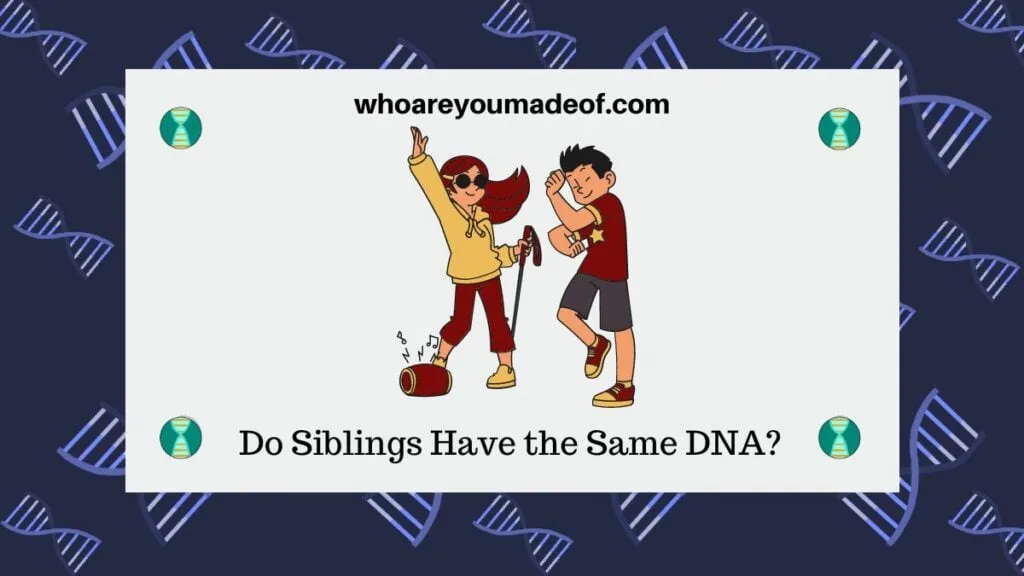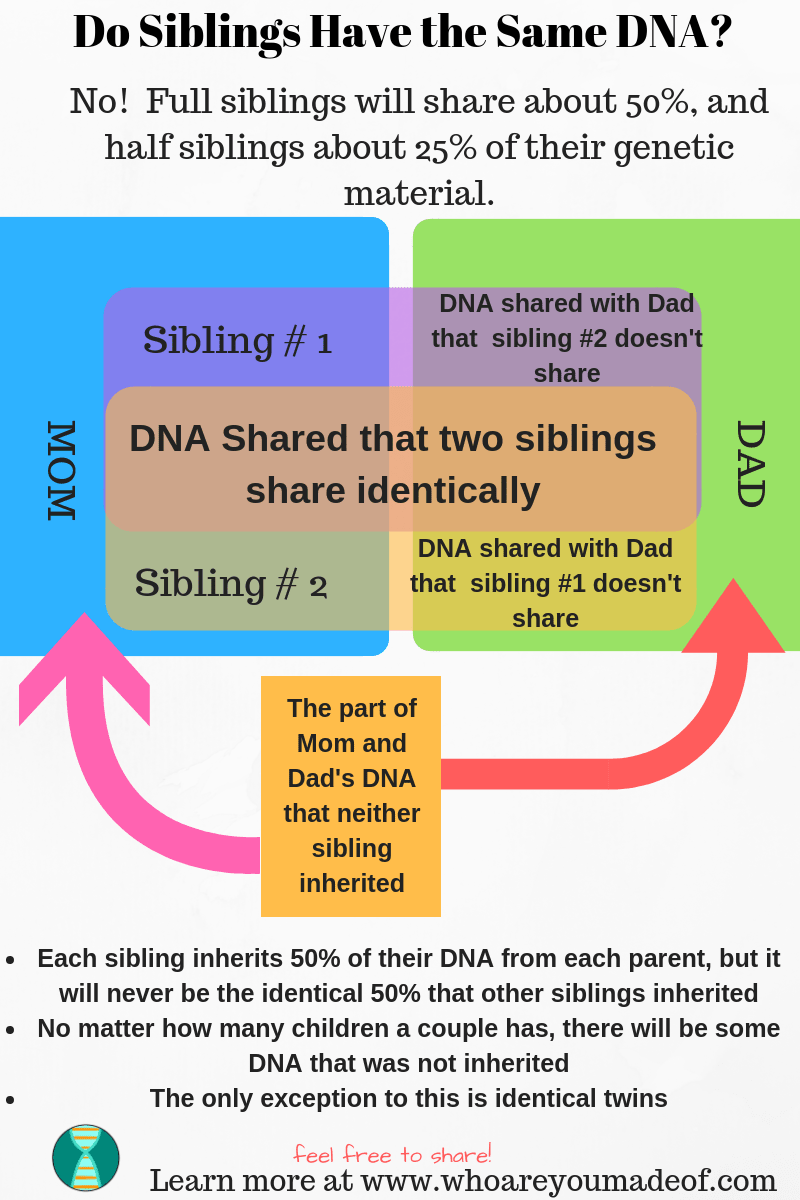Do siblings have the same DNA? In this post, I'll explain why sibling don't have the same DNA, as well as how siblings inherit different DNA from their parents.
People often ask this question when they first get their DNA results back, or when they get a new, close DNA match. They might be trying to figure out whether their sibling is a full or half-sibling.
The second most popular reason for asking this question?

Some people believe that if one of their siblings has done an Ancestry DNA test, there is nothing new to learn from other siblings doing the test, too. You'll find out below why this isn't true at all!
In this post, you'll learn:
- Whether siblings have the same DNA
- How much DNA full siblings and half-siblings share
- What you can learn from having a sibling - or all of your siblings - do a DNA test, too
Let's get started!
So, Do Siblings Have the Same DNA?
The answer is no, siblings do not have identical DNA, even if they share both parents in common. The only exception to this is in the case of identical siblings, since their DNA is exactly alike.
Siblings share some DNA with each other, but at least half of their DNA will be different. How can this be?
Why don't full siblings have the same DNA?
You inherit 50% of your DNA from each parent, but that equals only half of each of your parent's DNA. In other words, you got half of your mother's DNA and half of your father's.
This means that there was 50% of each parent's DNA that you didn't inherit. The portion of DNA that you did and didn't inherit was selected in an entirely random way.
Your sibling inherited DNA in a similar way, meaning that they also got a random 50% selection of your mom and dad's DNA.
Since the process is random, at least as far as scientists can tell. What we know about random selection and statistics leads us to the fact that there is no way that each of you randomly inherited the exact same 50% of each parent's DNA.
Some will be the same, while other portions of the DNA that you both got from your shared parents will be different.
The process of DNA inheritance is complicated, and many people are really overwhelmed when they realize how much they will have to learn about it in order to really make sense of their DNA results.
The jellybean example
While I am over-the-moon in love with DNA testing, there is some pretty crazy science involved behind the scenes. That's why I love the jellybean analogy.
- Imagine that you are sitting in front of two giant jugs of jellybeans. Each jug has 7,000 jellybeans, and each jug represents DNA from each of your parents. You are instructed to pour half of each container into a new jug, which represents your own DNA.
- You then put them back.
- Your sister or brother comes along, and is instructed to do the same thing (let's pretend, in our story, that the jellybeans magically were poured back into the right jug for mom or dad). Your sibling pours jellybeans from each container into their own jug.
How many matching jellybeans do you think you each got? Chances are that about 50% of your jellybeans were the same, and about 50% of them were different. This is a very simplified example of the way that DNA inheritance works.
When your parents conceived you, the DNA that you randomly inherited from each parent was already programmed into the sperm and the egg. A statistician could probably give us the exact odds, but all we really need to know is that probability favors about half of your randomly chosen jellybeans matching the ones that your sibling selected.
(There is a more detailed explanation below for those who want to learn even more about this)
In this image below, I illustrate overlapping shared DNA between siblings, and what is not shared:

How much DNA do siblings share with each other?
As you see from the above graphic, full siblings should share about 50% of their DNA with each other. This amount varies naturally, however, from about 32-54%.
The numbers for half-siblings varies, too. Half-siblings share between 18-32% of their DNA.
Measured in centimorgans, which is the typical unit of measurement that is used to describe the length of DNA segments shared between relatives:
- Full siblings: 2300-3900 centimorgans
- Half-siblings: 1300-2300 centimorgans
Siblings share lots of DNA segments
I have a confession. There is a pretty big flaw in my jelly bean example.
Do you remember about centimorgans being the unit of measurement for shared DNA? The jellybean example can give the impression that each centimorgan is inherited separately, like in an individual piece.
In reality, this is not how it works at all. Yes, you do inherit many centimorgans, but most of them are actually "stuck together" in what are called "DNA segments".
The centimorgans are not thrown into a big jug and mixed up, like my example could lead you to believe.
Forgive me - sometimes important details are lost in simplified explanations!
Siblings will share DNA segments on each chromosome
You have 22 numbered chromosomes that are relevant to our discussion here. If you remember from school that you actually have 23 chromosomes, you are right - the 23rd one is a chromosome that determines whether you are biologically male or female.
The inheritance patterns for the 23rd chromosome is very different than it is for the autosomal DNA, which is found in the 22 numbered chromosomes.
On each numbered chromosome, you will inherit some DNA from each parent. The genetic material will be passed down in long segments that will vary in length.
These segments are made up of our individual jellybeans, if you will.
If we imagine that your mother has a red, purple, blue, black, and white jellybean on her 2nd chromosome, you might have inherited the red, black, and white one, and it's possible that they all show up right there in a row on your 2nd chromosome.
Your sibling will have received DNA in long segments, too. If you have a sister, she might have inherited the red, purple, and black jellybeans.
It's possible that the red and purple ones are in one segment on the 2nd chromosome, and the black one is a segment by itself on the same chromosome.
If this were the case, you would have two identical DNA segments on that chromosome.
Siblings share segments on each chromosome
On each chromosome, you will have DNA segments that you share with your sibling. If your sibling is a full sibling, you should share lots of very long segments, and the total of those segments should add up to a number that falls within the range mentioned here in this article.
Half-siblings will share lots of segments, too, but they will be shorter and the total number will probably (but not definitely) add up to a number higher than those shared between siblings.
The result of all of this is that while some of your DNA is identical to that of your sibling, there is much that won't match. Additionally, if you have lots of siblings, you can even share more or less DNA with them than your other siblings do.
Note: Remember the red, purple, blue, black, and white jellybeans from chromosome 2? Did you notice that neither sibling inherited the red one? This is important to note for the next section.
What you can learn from having a sibling do a DNA test
So let's talk about that red jellybean. You didn't inherit it, and if your sister didn't do a DNA test, you don't even know about it. That red jellybean might contain a trace ethnicity that didn't show up on your report, or it might match a third cousin that doesn't match you - since 10% of our third cousins don't share DNA with us.
And that third cousin might have the key to breaking down the brick wall in your family tree.
If your mother did a DNA test, then you don't have to worry. The red jellybean was tested and the information contained within it will show up on her test results. However, sometimes our parents can't test, won't test, or are no longer with us.
This is why it's good to have as many siblings test as possible, when the parents are not available for whatever reason.
If both parents have tested, there is no additional information that can be learned about family history, since all of the DNA inherited by the siblings started out as DNA from the parents.
The only reason to test siblings if parents have already tested is if the siblings are curious to see what they inherited, or if they would just like to verify their relationships as full siblings.
If all of your siblings take a DNA test and upload their DNA data to Gedmatch, you can do really cool things like create a Lazarus kit, which is basically a recreation of your parents' DNA using the DNA of you and your siblings. You and your siblings have collectively inherited a majority of your parents' DNA, and the Lazarus kit splices the data together into a DNA kit for each of your parents.
Conclusion
I hope that you learned a little about how and why our DNA is not identical to that of our siblings. I am looking forward to hearing from you in the comments.
Thanks for stopping by!


Kim Glennon-Alty
Friday 15th of May 2020
Could a sibling sister have enough similar DNA to be identified as Birth Mother of 3 children?
Mercedes
Sunday 17th of May 2020
Him Kim, This could only happen if the mother and the sister are identical twins. Otherwise, the sibling sister would show up as a close family member, sharing between about 1300-2300 centimorgans (slightly more or less could also occur). Parents and children will always share more than about 3400 centimorgans. Thank you for the question, and I hope that this helps you, Mercedes